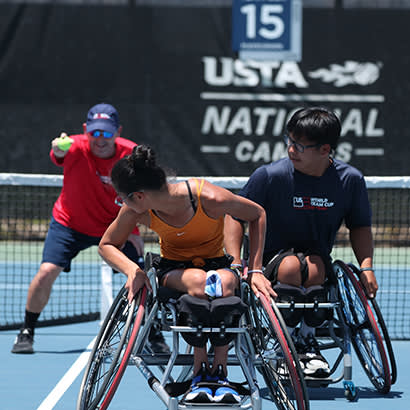
For an enhanced digital experience, read this story in the ezine.
During the past three years, nearly 5 million people in the United States have either picked up a tennis racquet for the first time or dusted one off to return to the courts. That number represents a diverse pool of players who hail from coast to coast, come from a variety of ethnic backgrounds, and are of all ages and abilities. The United States Tennis Association (USTA) hopes that its steadfast commitment to inclusion will revolutionize the ways in which sporting organizations think about the last part of that equation as it applies to their own adaptive and wheelchair sports.
While the USTA’s support of adaptive and wheelchair tennis programs far predates this recent surge in the sport’s overall participation (it was the first national governing body to integrate Paralympic sport into its operations when it took on the governance of wheelchair tennis in 1998), the landscape for both adaptive and wheelchair tennis within the organization has been transformed in recent years. In 2019, the USTA integrated its wheelchair operations into all of its business units, becoming the first national governing body in any sport to do so. Simply put: The USTA dissolved its once separate wheelchair tennis departments at the grassroots and professional levels and wove its staff and day-to-day operations into the corresponding departments that once exclusively handled only able-bodied tennis.
Jason Harnett, the USTA’s director of wheelchair tennis and head coach, says this historic step shows that tennis is tennis, no matter how it’s played. This thinking, he says, has permeated throughout the USTA at both the national and local section levels, and touched every area of the sport, from its tournament structure and player development pathway, through to local programming and development of coaches. The USTA currently sanctions more than 120 wheelchair tennis tournaments at all levels annually, and to date has registered 120 wheelchair-specific programs around the country. It provides these programs with guidance and national grants totaling between $50,000 and $100,000 per year — funds that Jennifer Edmonson, USTA national wheelchair committee chairperson, says are “pivotal in growing the game and have proven to be successful as wheelchair tennis opportunities continue to increase throughout the country.”
Setting the Standard
The USTA also has provided its coaches with the necessary tools to support the present and future of the sport. According to Jason Allen, Ed.D., the USTA’s manager of research and education for USTA-U — the association’s professional development initiative — the USTA advocated for the addition of wheelchair-specific language and content into the formalized certification provided by the Professional Tennis Registry (PTR) for all newly-certified teaching professionals, education that Allen says historically remained on the fringes. The association also holds annual wheelchair tennis camps at tennis clubs, public parks and recreation facilities around the country that Allen calls “the gold standard” for introducing the sport to new players and fostering mentoring relationships among coaches and athletes.
“The USTA hopes to be a blueprint for other national governing bodies that want to take on, assist or support the adaptive side of their sport, and we’ve loved to hear from others in the fields of adaptive and Paralympic sport that we are leading the way,” Allen says. “We still have a long way to go, but we’re laying the foundation each and every day, and hope that this investment will lead to seamless integration for future generations.”
Partnerships
In addition to its in-house wheelchair operations, the USTA also has a working relationship with grassroots adaptive tennis programs around the country. There are more than 350 adaptive tennis programs registered with the USTA nationwide that serve a variety of athletes with physical, cognitive and developmental, and emotional and social disabilities. On and off the court, these programs provide a critical outlet to a broad constituency within the public. According to the Centers for Disease Control and Prevention, there are nearly 61 million adults with disabilities in the United States, or 26 percent of all U.S. residents. By investing in these tennis programs, the USTA seeks to attract youth and adults who are often excluded from other athletic exploits and build a sense of community.
Advancing Adaptive Tennis
In addition to recently releasing the first-ever adaptive tennis coaching curriculum, the USTA sponsors financial grants to assist in the promotion, implementation and growth of adaptive tennis programs at the community level, and since 2019, has hosted the National Adaptive Championships at the USTA National Campus in Orlando, Florida. This unified doubles tournament consists of pairs comprising one adaptive-playing participant (athlete) and one non-adaptive-playing participant (partner). Locally, each of the USTA’s 17 sections have designated diversity and inclusion staff that help advance adaptive tennis at the grassroots level. They can effectively answer questions on a wide range of topics, including financing and procuring educational materials and equipment.
All of this has been a critical element in the USTA’s mission to grow the sport of tennis and ensure that the game is available and accessible to all. Tennis is tennis, and that is a mantra that has served the sport — and those who play it — particularly well. After all, a more inclusive sport is always a better sport.
Victoria Chiesa is Assistant Managing Editor for USTA Corporate Communications.

